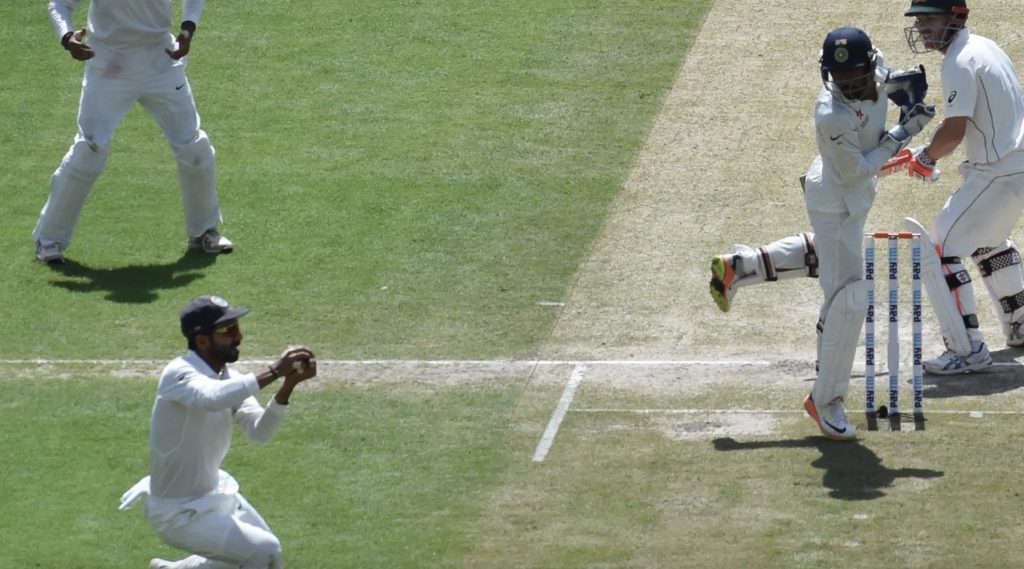
After India’s national cricket team played its first test in 1932, they were known for a long time to be terrible at fielding. The best bowlers of the century often complained that they had to make three chances for one catch to be made. This showed how unfit and unathletic most people were at the time. Sunil Gavaskar changed this in 1986. He was the first Indian outfielder to catch 100 balls at Edgbaston. Mansur Ali Khan Pataudi was the captain of the team at the time. Even though he had lost an eye in a car accident, he was a great fielder. The first Indian outfielder to do this was Sunil Gavaskar. Since then, five more people have reached that point, and one of them, Rahul Dravid, has set a new record for doing so. Virat Kohli was the last player to do this, and he still has a chance to pass VVS Laxman and become India’s number two batsman of all time. One can see these amazing catches via online cricket video.
- Rahul Dravid (209 catches in 163 tests) –
Rahul Dravid is the person who has caught the most balls in a Test match so far. Even if you didn’t play fantasy cricket in the 2000s, picking Dravid as your player was a good idea. He was always good at hitting and catching, and on average, he made more than one catch in each test. He could be trusted in both. He never had more than three catches in an inning, but he was Mr. Dependable behind the plate for a whole generation. In one inning, he never had more than three catches. Dravid spent a lot of his career in the slip cordon, an area of the field where he was very good, especially when Indian spinners were involved and he had to field close to the bat. Dravid did a great job of reacting to Anil Kumble, who often bowled quickly, and Harbhajan Singh, who could make the ball bounce in an unsettling way. Both of these bowlers could make their deliveries bounce in different ways. Dravid was often called on by the bowlers when they were trying to figure out the batters of the other team. In this role, he worked very closely with the wicketkeeper. In 2004, he played well against Australia. Throughout four games, he caught 13 balls.
- VVS Laxman (135 catches in 134 tests)-
While he was on the Indian national team, Laxman was never thought of as one of the best Indian athletes. On the other hand, Laxman was the most reliable catcher in the slip cordon and had great agility. When the ball got to him, his big hands would usually cup it as soon as it got there. He didn’t have to deal with hard things very often. Laxman was a great close-in catcher who set the tone for his team by being able to spot and turn Indian pitches. When India went outside of their continent, the slip cordon was moved even further back, but he still made a lot of great catches. In 2004, he had his best series against Australia. For four games, he caught seven balls. His best series was this one.
- Sachin Tendulkar (115 catches in 200 tests) –
Tendulkar did not spend most of his time in the slip cordon, unlike most of the other people who took part in this. One of the first things that fans of India’s cricket team remember about him is a great running catch he made at long-on in England in 1990. Even though Tendulkar’s catching wasn’t always as solid as his hitting, it was almost always more consistent and sound than either of those two skills.
- Mohammad Azharuddin (105 catches in 99 tests) –
If fantasy cricket had been around in the middle of the 1980s, Mohammad Azharuddin would have been a popular choice because of how well he batted, how fast he played on the ground, and how amazing his catches were. When India’s captain in the 1990s, he suggested that the best way to win at home was to have sharply spin-friendly surfaces that would show where visiting batsmen were weak against the turning ball. This pattern was made by India for the first time at this time. Even though it was important to make these kinds of surfaces, this was only part of the problem.
- Sunil Gavaskar (108 catches in 125 tests) –
Gavaskar would often stand on the field in front of the batter when the famous spin quartet was at bat. Once he had shown that he could be trusted as a team member, on the other hand, he spent most of his time guarding the slip cordon. In 1982 at The Oval, Ian Botham hit a ball straight at him while he was at a silly point. This was the most serious injury he got while fielding. But he did his best work as a fielder in the slips, where he faced both fast and slow bowling. Even though it wasn’t easy to keep to some of the spinners, Gavaskar was able to hold on to a lot more difficult opportunities than he lost.
- Virat Kohli (100 catches in 99 tests) –
When Virat Kohli moved to the cordon right after Dravid and Laxman left, some harsh insults were shouted at him. It’s not easy to be a good slip catcher, so when he did it, some harsh insults were shouted at him. Kohli was a great infielder, but at the beginning of his career, he dropped a few easy catches. This was because he was always trying to get to the ball before it got to him, but he never managed to do so. But he made a lot of progress when he finally calmed down and started talking to the other people in the room. Under his leadership as captain, India built up a fast bowling arsenal that is the envy of the cricket world, and the slips never ran out of chances to make catches while he was in charge.
Know all about cricket betting and updates at CBTF.
Get the fastest cricket news update at https://cbtfspeednews.com/.
Know all about cricket updates at CBTF.






